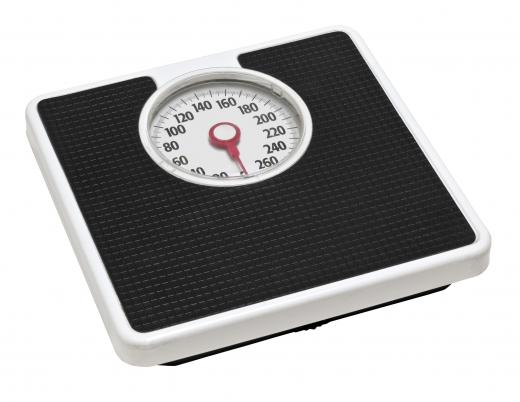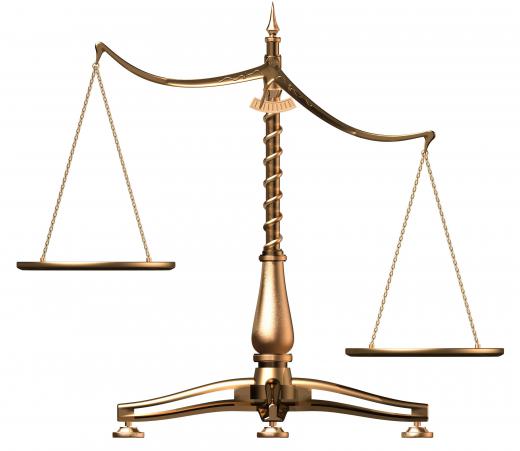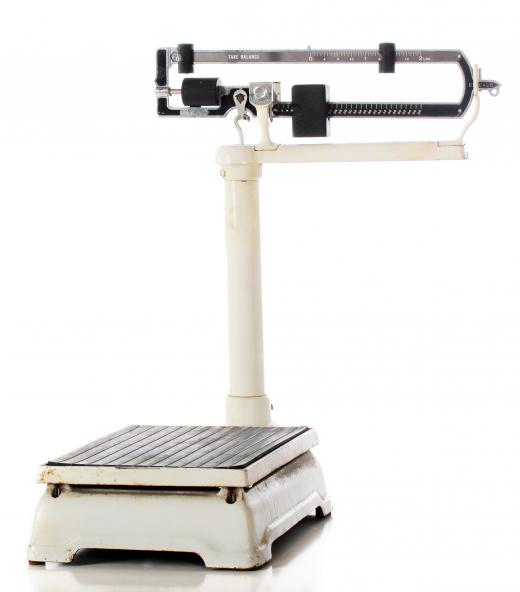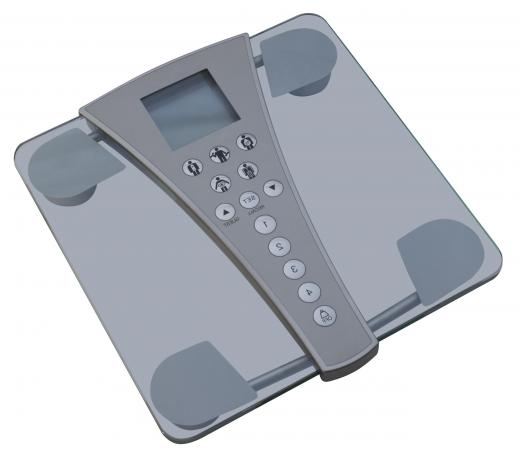What Is a Weight Scale?
A weight scale is any device used to determine the weight of an object; it normally includes a scale that indicates the weight or compares the object to calibrated known weights. Scales of many types have been in existence since prehistoric times, and may have been as simple as comparing an item to be purchased in one hand with a stone in the other hand. In the 21st century, scales can measure everything from small particles to spacecraft, using technology from complex digital equipment to simple balance scales used for thousands of years.
Lost to history is any indication of when humans first used scales. Sales of goods by weight have been common for thousands of years, and may have first been accomplished by hanging an item on one end of a stick and balancing it with a stone or other object for comparison. Over time, the need for consistent business practices led to development of standard weights and measures. The Romans are often credited with development of the weight scale and terms such as the pound used to describe weight.

On Earth, weight and mass are the same, due to the Earth's gravity. A weight scale measures the mass of an object or person under the effect of Earth's gravitational pull, known as one gravity. On other planets with less gravity, an object will weigh less but its mass does not change. In space, objects are called "weightless", which does not mean that they have lost mass, only the effects of gravity that can be measured on a weight scale. This can be seen by floating physical activities with no resistance or direction.

A simple scale used since Roman times is the balance or beam scale. Balance scales often consist of a horizontal arm or beam supported at its center, with a basket or tray supported at each end. Materials to be weighed are placed on one tray, a reference weight of a known amount is placed on the other tray, and either the weight is changed or materials are added or removed until the two are balanced and the beam is horizontal.

By the 19th century, scales were developed using calibrated springs to weigh materials. Objects to be weighed were placed on a flat table connected to a wound spring mechanism, with a pointer attached at the center of the spring. These devices can help determine obesity or cases where a person is underweight. The weight of the object turned the spring and the pointer indicated the weight on a printed or engraved dial or chart, allowing a direct measurement without the need to add weights or adjust a balance beam. This is the perfect device to check if one's diet is starting to work, and if they're finally at their target weight.

With the development of electronics in the 20th century, a weight scale could be manufactured with minimal moving parts. A digital force meter could be attached at the bottom of the weighing table, and an electronic signal sent to processing equipment that could read the weight directly. These digital scales were portable, durable and easy to calibrate. It's not uncommon to find these devices in dietitian offices because of how practical and convenient they are. Many developed countries in the 21st century weighed commercial road trucks, both to assess trucking companies for road taxes, and to prevent overweight trucks that were unsafe and damage roads.

The key to good weight measurement is knowing that the scale is accurate. Calibration is needed on a regular basis, and since historic time different societies came up with a wide range of calibration techniques, naming systems and regulations. Different countries may have used varying weight systems, but it became apparent that standard calibrated weights were needed so that all scales were adjusted similarly.
Over time, governments began creating standard weights and measurements for commercial goods, both to prevent fraud and to provide a basis for taxation. Many countries in the 21st century had agencies responsible for inspecting and certifying scales used for selling a wide range of goods. Calibrated weights were carefully manufactured, maintained and cross-checked so that all scales were consistent in their measurements.
AS FEATURED ON:
AS FEATURED ON:















Discussion Comments
The next weight scale I buy for my bathroom is going to have to be a lot more accurate than the old spring model I'm using right now. My doctor told me I needed to keep track of my weight loss while I'm on this new medication, so I can't rely on something that adds two or subtracts three pounds every day. I'm looking at a really nice electronic bathroom scale with a large digital display.
When I worked in a restaurant storeroom, I depended on a weight scale for just about everything I did. If someone needed 2 pounds of sugar for a recipe, I had to weigh it out precisely. If we cooked a 20 pound roast beef, I'd have to weigh how much came back at the end of the night.
I also had to know how much each container weighed so I could adjust for a tare weight, and the "clean" weight of different vegetables. If a recipe called for 5 pounds of onions, for example, I had to weigh out 7 pounds to account for all the unusable outer layers.
Post your comments